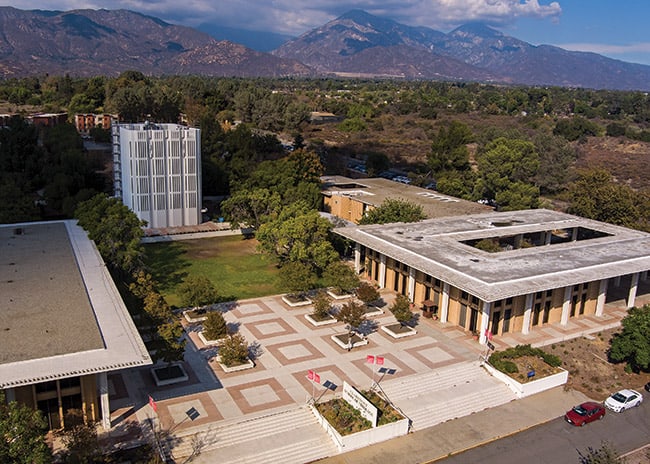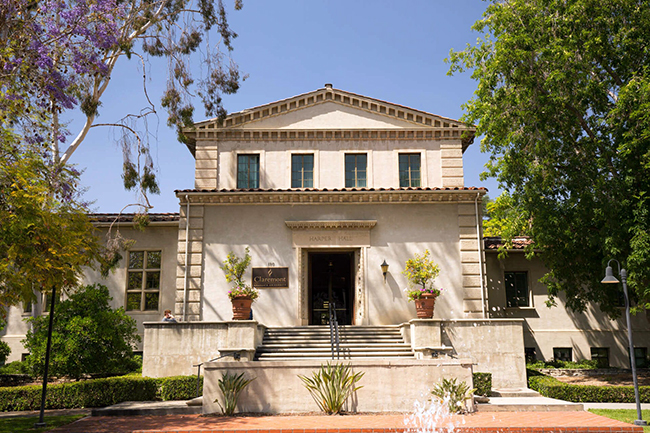TCC vs. CST: A deal gone sour—podcast, court docs

by Mick Rhodes | mickrhodes@claremont-courier.com
A once strong partnership turned bitter over the purchase price of School of Theology property.
On June 5, 1957, The Claremont Colleges signed off on a real estate transaction with the Southern California School of Theology (soon to be known as the Claremont School of Theology) to sell 16.4 acres of its Village-adjacent land for $107,500.
Both entities thrived in the intervening years.
The founders of CST hoped to develop the property and turn the school, which traces its roots back to 1885, into a world-class theological college. They succeeded.
The Claremont Colleges were also heavy on ambition. Over the years the consortium of seven schools grew in size and prestige, so much so that today many populate the upper ranks of the top private liberal arts institutions in the United States. The Colleges’ collective endowment would also grow over the decades, swelling to a reported $4 billion.
Both parties coexisted happily for nearly 60 years, but in 2015, the relationship hit the rocks, hard.
It has now deteriorated to the point that it resembles a contentious high-profile divorce case, with both trading barbs and accusations in and outside of courtrooms, with tens of millions of dollars at stake.
The slide began sometime around August 11, 2015, when, according to Claremont School of Theology President Jeffrey Kuan, the school sent a letter notifying the Claremont Colleges it intended to sell the property. The school was hoping to maintain ownership of about six acres of the 16.4 acre campus so that it could continue to operate there, albeit on a smaller footprint.
The Colleges replied it would purchase the remaining 10.59 acre parcel.
The School of Theology hired Pasadena-based Valbridge Property Advisors to conduct an appraisal. On May 31, 2016, Valbridge submitted its 220-page report, pegging the value of the entire parcel at $39.8 million. The appraisal indicated the portion TCC was looking to buy was worth $25.4 million.
The Colleges, in a letter dated August 1, 2016, stated it had its own appraiser do a “peer review” of Valbridge’s calculations. That review alleged “significant flaws” in the underlying core assumptions of the Pasadena firm’s appraisal. It offered $14 million for the 10.59 acre parcel, contending that figure represented its actual fair market value. The offer included a stipulation that CST students be given the right of first refusal to lease 87 student housing units it planned to renovate on the parcel it proposed to re-acquire.
That $11.4 million gap between CST’s proposed value of $25.4 million and the Colleges’ offer of $14 million is at the core of the conflict, which has now dragged on for more than five years.
Sounds simple, right? But it’s not just a squabble over the fair market value of a big chunk of prime Claremont Village adjacent real estate.
It turns out the original bill of sale—that 1957 agreement—contains a clause both parties agree would, under the right set of circumstances, allow TCC to buy back the land for about $4 million, a fraction of its current value.
While CST acknowledges the clause exists, it says TCC voided it when it failed to provide a formal first offer to purchase the land within six months of the school notifying it, on August 11, 2015, of its intent to sell the property.
The Claremont Colleges dispute this assertion, maintaining its $14 million offer is more than generous, [adding if it went by the letter of the 1957 agreement’s “first offer” clause, it could pay just $4 million and be done with it. ]
At loggerheads, the two parties naturally ended up in court.
The Colleges say CST’s motivation to initiate the litigation was to find a way to be released from a legally binding agreement that has been in place for 64 years.
The school says the agreement is no longer binding, citing California’s Marketable Record Title Act (Civ. Code, § 880.020 et seq.). Los Angeles County Superior Court Judge Dan Thomas Oki apparently agreed, concluding “both the Educational Use Clause and the First Offer Clause had expired on January 1, 1988.”
Further, Judge Oki ruled the modern day interpretation of the first offer clause in the 1957 agreement was instead a first “right of refusal” in the event CST would choose to sell or transfer all or a portion of its property. His judgement went on to state it found both the educational use clause (which dictated the land would be used for educational or institutional use only, in perpetuity) and first offer clause constituted “equitable servitudes enforceable by injunction.” It then went on to conclude “the calculation…for the repurchase of [CST’s] property by [TCC] constitutes an unreasonable forfeiture and is unenforceable,” and “strict enforcement of the [first offer clause], and its method of calculating the price to repurchase the property, would result in [CST] suffering a forfeiture of as much as $36 million, being the difference between the purchase price calculation under the 1957 Agreement and the current fair market value of the property.”
Nevertheless, Judge Oki’s January 19, 2019 judgement stated, “CGU and Consortium,” aka TCC, “are the prevailing parties in this action.”
The case was then bumped up to California’s Second District Court of Appeal. That body’s January 22, 2021 judgement agreed with the Colleges’ assertion that both parties had essentially “amended and reaffirmed” the terms of the 1957 agreement over the course of business they had jointly undertaken in 2001 and 2006, and “reversed and remanded” Judge Oki’s decision back to the lower court.
“We conclude that enforcing the First Offer Clause as written would operate no forfeiture to either party; indeed, each party would receive that for which they bargained, and that to which they agreed,” wrote the appellate court in its judgement. “Whether [CST] stays at its location in Claremont or moves and triggers the First Offer Clause, it will have received what it bargained for. That more than six decades have passed and land has appreciated in value does not render the terms of the parties’ agreement a forfeiture for either party. Rather, the trial court’s ‘interpretation’ of the First Offer Clause as a first right of refusal would materially alter the parties’ allocation of their respective risks and contractual rights and responsibilities. Absent a forfeiture to be avoided, the forfeiture doctrine is inapplicable.”
The Colleges are dug in, citing the appellate court’s affirmation of the 1957 agreement as binding. They are ready to move forward with the sale at $14 million.
School of Theology President Kuan says TCC is attempting to rush the process, and that there are additional matters yet to be adjudicated before a potential sale between the parties can proceed.
It’s a head-spinning legal conflict, with tens of millions of dollars in the balance, as well as the future of CST.
The COURIER talked to both CST President Kuan and Stig Lanesskog, CEO of The Claremont Colleges Services, in an attempt to provide some measure of clarity.
“I had a conversation with the president of CST at the start of this process, Jeffrey Kuan,” Lanesskog told the COURIER. “We both acknowledged this 1957 agreement was there. We both acknowledged —and we did many times in writing as well — that we would negotiate outside of that agreement to try to come up with an arrangement that we thought would help them. I feel like we bent over backwards to try to do that, knowing that we had this 1957 agreement that they also acknowledged. Because quite frankly we felt like that 1957 agreement was very clear that we could buy it back for a very low price, and we offered a lot more than that.”
Mr. Kuan says it’s an oversimplification to argue that if it goes by the letter of the law, TCC only has to pay $4 million for the property. He says a stipulation in one of the court cases states CST can demand arbitration. It has not yet made that demand because, as he sees it, TCC has not yet made a formal offer. Further, he said, TCC missed the six-month window to make a formal offer, as stipulated in the 1957 deal, which should also void the agreement.
“That was just a discussion,” Mr. Kuan said of the Colleges’ initial $14 million figure. “They backed off and said, ‘This is not a formal offer.’” He also said it was made clear to him the TCC offer was “final.” “There was no negotiation. No room for negotiation.”
“We tried to set [the 1957 agreement] aside and try to negotiate in good faith on this,” Lanesskog said. “After us providing that offer, the $14 million plus to renovate the housing, their response was to sue us to try to invalidate the 1957 agreement. That was our reward for attempting to work with CST to address both their financial situation and their housing challenges.”
Kuan said CST felt its only recourse was to take TCC to court in an effort to have the 1957 agreement modified, nullified, or convince a judge to rule it was free to renegotiate so that it could get what it feels is fair market value for the property.
“We have asked for them to bring their appraisal,” Kuan said. “We have our appraisal. Bring your appraisal, and we sit down, and if we’re serious about talking about fair market value, show us your appraisal, a legitimate appraisal from a firm that has a reputation. We sit down and talk. But the problem is they dug their heels in. They were not willing to engage in that kind of process.”
Some have suggested the Claremont Colleges should simply dip into its $4 billion combined endowment and pay what CST claims to be the fair market value for the property. Lanesskog says that line of thinking is misguided.
“We believed we were paying the market rate. The market rate is not 40 million dollars,” Lanesskog said, referencing Walbridge’s 2016 $39.8 million appraisal for the entire 16.4 acre parcel. “The market rate was what we offered at that time. And that was, again, incredibly generous given the fact that we knew we had this 60-year agreement in place that said we could purchase it for a fraction of that. And we never pursued that. We never pursued trying to pay the four million or less for that property. We approached it from a market-based position.
“It’s not as David and Goliath as maybe some might want to position it.”
Kuan asserted repeatedly that TCC has not negotiated in good faith to end the stalemate over the now five-year conflict.
“If they want the land, we [will] sell them the land. But in the process, treat us justly and fairly, and provide us with some sense of a fair market value, so that the mission of the school can continue. It’s all about the mission of the school.”
Kuan acknowledged CST has had its financial woes. It has been operating at a deficit for more than a decade, he said, and over the past two-and-half years has added $5 million in debt to its books. But after a series of cost-cutting measures, including laying off some 30 staff members, eliminating some faculty salaries through attrition and early retirement, and outsourcing the business operations of its dean’s office, the school’s 2021-22 budget is in the black for the first time since before Kuan arrived nine years ago.
If CST can get what it sees as fair market value for the portion of its property the Colleges are looking to purchase, it will pay off its $5 million debt, Kuan said, and use the balance to establish a nest egg for future operating capital.
But both must first figure out a path forward through their seemingly endless legal wrangling. And that doesn’t appear to be happening any time soon.
“It’s sad. It’s disappointing,” Lanesskog said. “It’s a place we had a good relationship with for many years. And it’s just so unfortunate that it’s come to this point.”
“We still have around 300 students,” Kuan said. “We are still a viable institution. And our academic programs continue to be of top quality. We are looking for a way to be financially solvent so that we can continue training these students. That’s what we are looking for. At any point in time, if they are ready to come to the table, we are ready to sit down and talk and find a way to settle this.”
This story is quite honestly mind-numbingly complex. Its tentacles extend outward into multiple sub-categories, and background information to numerous letters and legal documents of various vintage. Frankly, the sheer volume of information makes it nearly impossible to paint a complete picture within the space constraints of a COURIER news story.
For a look at some of those numerous background and court documents, check out the PDFs pages below.








0 Comments